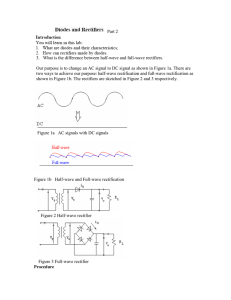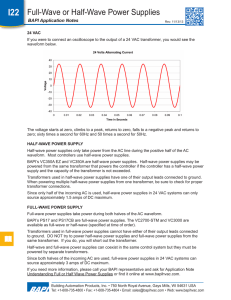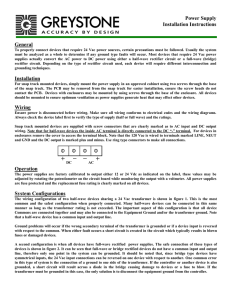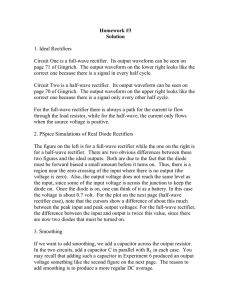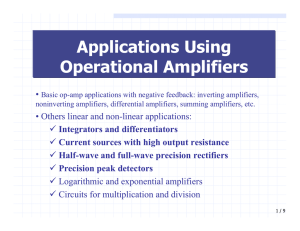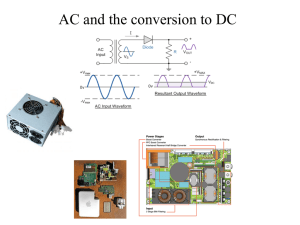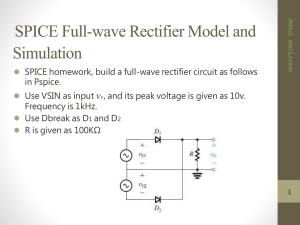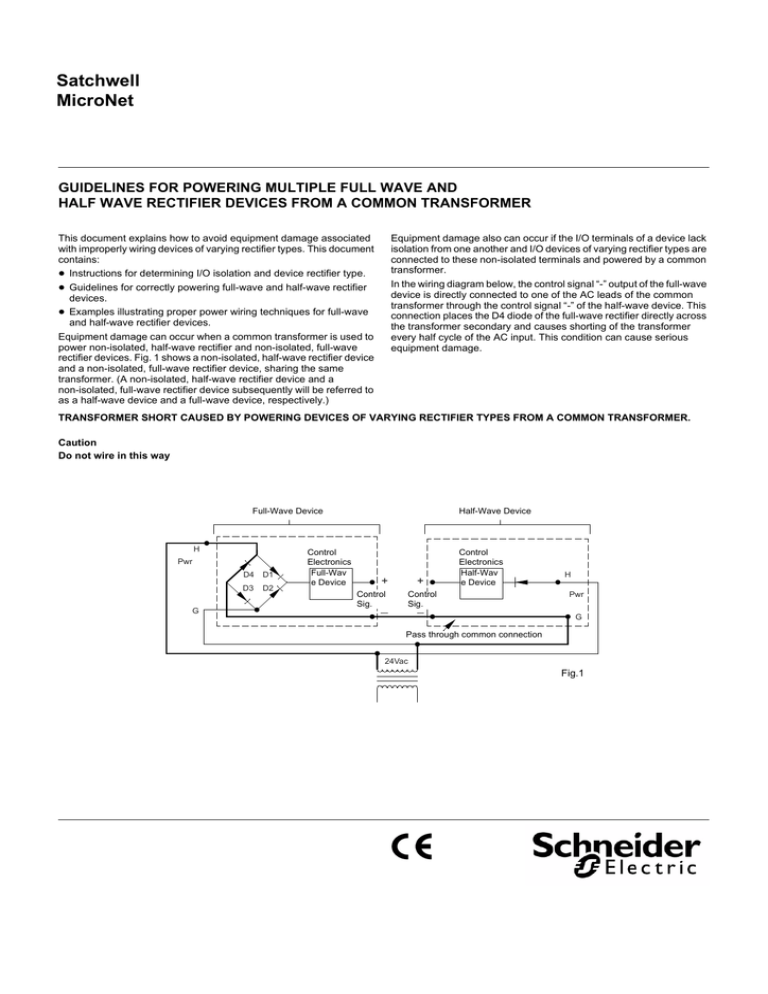
Satchwell
MicroNet
GUIDELINES FOR POWERING MULTIPLE FULL WAVE AND
HALF WAVE RECTIFIER DEVICES FROM A COMMON TRANSFORMER
This document explains how to avoid equipment damage associated
with improperly wiring devices of varying rectifier types. This document
contains:
• Instructions for determining I/O isolation and device rectifier type.
• Guidelines for correctly powering full-wave and half-wave rectifier
devices.
• Examples illustrating proper power wiring techniques for full-wave
and half-wave rectifier devices.
Equipment damage can occur when a common transformer is used to
power non-isolated, half-wave rectifier and non-isolated, full-wave
rectifier devices. Fig. 1 shows a non-isolated, half-wave rectifier device
and a non-isolated, full-wave rectifier device, sharing the same
transformer. (A non-isolated, half-wave rectifier device and a
non-isolated, full-wave rectifier device subsequently will be referred to
as a half-wave device and a full-wave device, respectively.)
Equipment damage also can occur if the I/O terminals of a device lack
isolation from one another and I/O devices of varying rectifier types are
connected to these non-isolated terminals and powered by a common
transformer.
In the wiring diagram below, the control signal “-” output of the full-wave
device is directly connected to one of the AC leads of the common
transformer through the control signal “-” of the half-wave device. This
connection places the D4 diode of the full-wave rectifier directly across
the transformer secondary and causes shorting of the transformer
every half cycle of the AC input. This condition can cause serious
equipment damage.
TRANSFORMER SHORT CAUSED BY POWERING DEVICES OF VARYING RECTIFIER TYPES FROM A COMMON TRANSFORMER.
Caution
Do not wire in this way
Full-Wave Device
H
Pwr
G
D4
D1
D3
D2
Control
Electronics
Full-Wav
e Device
Half-Wave Device
+
+
Control
Sig.
Control
Electronics
Half-Wav
e Device
Control
Sig.
H
Pwr
G
Pass through common connection
24Vac
Fig.1
IDENTIFICATION
WIRING GUIDELINES
DEVICE RECTIFIER TYPE
Note:
Transformer must be properly sized before installation.
COMMON TRANSFORMER
To find out if a device is half-wave, full-wave, or isolated:
1. Examine product literature or device markings for an indication of
device rectifier type. If you are unable to identify the device as
half-wave, full-wave, or isolated, proceed to next step.
2. Use an ohm meter to take two measurements:
a. the resistance between one of the power supply input
terminals and the signal common terminal.
b. the resistance between the other power supply input terminal
and the signal common terminal.
3. Record the two measurements and compare with the following
statements:
• One very low (near zero) measurement and one very high
measurement (near infinity) indicates the device has a half-wave
rectifier.
• Two large, nearly equal measurements indicates the device has a
full-wave rectifier.
• Devices with internally isolated power supplies show no evidence
of continuity between the common terminal and either of the
power supply input terminals. The ohmmeter indicates infinite
resistance between the common and each power supply input
terminal.
4. Proceed with correct wiring by consulting the Wiring Guidelines
section below.
I/O ISOLATION
Equipment damage also can occur when I/O devices of varying rectifier
types share a single transformer and are connected to a common
device which lacks isolation between its individual I/O terminals.
To find out if the I/O (universal inputs, digital inputs, digital outputs, and
analogue outputs) of a device are isolated from one another:
1. Use an ohm meter to measure resistance between various I/O
common terminals.
2. Record several measurements and compare with the following
statements:
• Devices with internally isolated I/O have very high measurements
(near infinity) when resistance between any two common I/O
terminals is measured.
• Devices that do not have internally isolated I/O have very low
measurements (near zero) when resistance between any two
common I/O terminals is measured.
3. Proceed with wiring by consulting the Wiring Guidelines section.
2
• Devices with internally isolated power supplies may share a
common transformer.
• If all input and/or output devices are line voltage devices (isolated
devices), a common transformer can be shared between devices of
same rectifier type.
• Full-wave devices may share a common transformer as long as
there are no interconnections between I/O devices (universal inputs,
digital inputs, and analogue outputs) supplied by the common
transformer.
• Half-wave devices may share a common transformer as long as
wiring polarity (24Vac to 24Vac and 0V Com to 0V Com) is
maintained.
EXTERNAL ISOLATION TRANSFORMERS
• Non-isolated, connected devices of varying rectifier types require
their own external isolation transformers.
• Use external isolation transformers for each device if there is doubt
regarding whether an installation may cause equipment damage.
EXAMPLES
EXAMPLE NO. 1
The following examples show half-wave and full-wave devices properly
wired. Keep in mind that these examples do not address all
installations.
Caution:
If you have any doubt regarding whether your installation may
cause equipment damage, provide each device with its own
transformer.
Power Multiple Full-Wave Controllers from a Single Transformer
Note:
Multiple full-wave controllers may be powered from a single
transformer if the following requirements are met:
• There are no interconnections between the universal inputs, digital
inputs, digital outputs, or analogue outputs of any of the controllers
powered by the common transformer.
• None of the I/O devices connected to the controllers (universal
inputs, digital inputs, or analogue inputs) are powered by the same
transformer supplying the controllers unless the I/O devices have
internally isolated power supplies.
MULTIPLE FULL-WAVE CONTROLLERS POWERED FROM A SINGLE TRANSFORMER
24Vac
24H
24G
Full-Wave
Device
24H
24G
Full-Wave
Device
24H
24G
Full-Wave
Device
24H
24G
Full-Wave
Device
Fig.2
3
EXAMPLE NO. 2
Use Separate Transformers to Power Full-Wave Controllers and
Half-Wave Actuators
A full-wave controller connected to half-wave actuators must be
powered by separate transformers. One or more half-wave actuators
may share a transformer but the full-wave controller must have its own
separate transformer as shown below.
SEPARATE TRANSFORMERS FOR HALF-WAVE ACTUATORS AND FULL-WAVE CONTROLLER
Half-Wave
Actuator
+
24G/COM
24H
Full-Wave
Device
Half-Wave
Actuator
AO1
COM
AO2
COM
+
24G/COM
24H
24H
24G
24Vac
Fig.3
EXAMPLE NO. 3
Use a One-to-One Transformer to Isolate Full-Wave Controller and
Half-Wave Actuator
A transformer with a one-to-one ratio may be used for isolation
purposes. In Fig.4, a full-wave controller and a half-wave actuator
share a 24Vac transformer when the actuator is isolated from the
controller through a separate one-to-one ratio 24Vac transformer.
USE OF A ONE-TO-ONE TRANSFORMER TO PROVIDE ISOLATION BETWEEN A HALF-WAVE ACTUATOR AND A FULL-WAVE
CONTROLLER
Half-Wave
Actuator
Full-Wave
Device
AO
COM
24G/COM
24H
24H
24G
Fig.4
4
EXAMPLE NO. 4
Provide Isolation with a Dual Secondary Transformer
In Fig.5 below, a dual isolated secondary transformer is used to
provide isolation for a full-wave controller and a half-wave actuator.
Any non-isolated device connected to these controllers must be
isolated by a separate transformer.
FULL-WAVE CONTROLLER AND HALF-WAVE ACTUATOR ISOLATED WITH A DUAL SECONDARY TRANSFORMER
Half-Wave
Actuator
Full-Wave
Device
AO
COM
24G/COM
24H
24H
24G
Fig.5
EXAMPLE NO. 5
Use a Single Transformer to Power a Full-Wave Controller and
Isolated, Half-Wave Actuators
As shown in Fig.6, devices with built-in isolation can be powered by a
common transformer. Any non-isolated, I/O device connected to the
non-isolated, full-wave controllers shown below must be isolated by a
separate transformer.
FULL-WAVE CONTROLLER AND ISOLATED, HALF-WAVE ACTUATORS SHARING A TRANSFORMER
Full-Wave
Device
AO1
COM
AO2
COM
Sig.+
Isolated
Sig. - (COM) Half-Wave
Actuator
24H
24G
24H
DEVICES
Sig.+
Isolated
Sig. - (COM) Half-Wave
24H
Actuator
24G
24G
Full-Wave
Device
AO1
COM
AO2
COM
Sig.+
Isolated
Sig. - (COM) Half-Wave
24H
Actuator
24G
24H
24G
Sig.+
Isolated
Sig. - (COM) Half-Wave
24H
Actuator
24G
Fig.6
5
EXAMPLE NO. 6
Use Separate Transformers for Half-Wave Actuators and
Full-Wave Controller
When I/O devices of varying rectifier types are connected to a full-wave
controller, the controller must have its own transformer. If all I/O
devices have half-wave rectifiers, then a single transformer can be
used to power all of the I/O devices shown in Fig.7.
SINGLE TRANSFORMER FOR HALF-WAVE DEVICES AND SEPARATE TRANSFORMER FOR FULL-WAVE CONTROLLER
4 to 20mA
Transmitter
+
24H
24G
Half-Wave Devices
4 to 20mA
Transmitter
+
24H
24G
Full-Wave
Device
250 ohm
250 ohm
AI1
COM
AI2
COM
AO1
COM
AO2
COM
Half-Wave
Actuator
Input
24G/COM
24H
24H
24G
24Vac
24Vac
Half-Wave
Actuator
Input
24G/COM
24H
Fig.7
EXAMPLE NO. 7
Use Separate Transformers for Full-Wave Transmitters and
Half-Wave Controller and Actuators
When I/O devices of varying rectifier types are connected to a
half-wave controller, the controller can share its transformer with the
half-wave devices, but the full-wave devices must use a separate
transformer shown in Fig.8.
SINGLE TRANSFORMER FOR HALF-WAVE DEVICES AND CONTROLLER AND SEPARATE TRANSFORMER FOR FULL-WAVE
DEVICES.
4 to 20mA
Transmitter
Full-Wave Devices
4 to 20mA
Transmitter
COM +
24H
24G
Half-Wave
Device
250 ohm
COM +
24H
24G
250 ohm
AI1
COM
AI2
COM
AO1
COM
AO2
COM
Half-Wave
Actuator
Input
24G/COM
24H
24H
24G
24Vac
24Vac
Half-Wave
Actuator
Input
24G/COM
24H
Fig.8
6
EXAMPLE NO. 8
Use Separate Isolation Transformers to Power a Single Input
Device Connected to Multiple Full-Wave Controllers
A single input device (transmitter) may be connected to two or more
full-wave controllers if each controller and input device has its own
separate isolation transformer as shown in Fig.9.
FULL-WAVE CONTROLLERS SHARING NON-ISOLATED I/O DEVICES WITH SEPARATE TRANSFORMERS
4 to 20mA
Transmitter
+
24H
Half or Full-Wave
Input Device
Full-Wave
Device
250 ohm
AI1
COM
24H
24G
24G
Full-Wave
Device
AI1
COM
24H
24G
Fig.9
EXAMPLE NO. 9
Use Separate Isolation Transformers to Power a Single Full-Wave
Input Device Connected to Multiple Half-Wave Controllers
A single full-wave input device (transmitter) may be connected to two
or more half-wave controllers if the controllers and input device have
their own separate isolation transformer as shown in Fig.10 and Fig.11.
HALF-WAVE CONTROLLERS SHARING NON-ISOLATED FULL-WAVE I/O DEVICE WITH SEPARATE TRANSFORMERS
4 to 20mA
Transmitter
Full-Wave
Input Devices
COM +
24H
Half-Wave
Device
250 ohm
24G
AI1
COM
24H
24G
Half-Wave
Device
AI1
COM
24H
24G
Fig.10
SINGLE TRANSFORMER FOR HALF-WAVE CONTROLLERS SHARING NON-ISOLATED HALF-WAVE I/O DEVICES
Half-Wave
Device
A01
COM
A02
COM
Half-Wave
Actuator
250 ohm
Input
24G/Com
24H
24H
24G
Half-Wave
Actuator
Input
24G/Com
24H
Fig.11
7
Cautions
• Information is given for guidance only and Schneider Electric does
not accept responsibility for the selection or installation of its
products unless information is given by the Company in writing
relating to a specific application.
On October 1st, 2009, TAC became the Buildings business of its parent company Schneider Electric. This document reflects the visual identity of Schneider Electric,
however there remains references to TAC as a corporate brand in the body copy. As each document is updated, the body copy will be changed to reflect appropriate
corporate brand changes.
Copyright © 2010, Schneider Electric
All brand names, trademarks and registered trademarks are
the property of their respective owners. Information contained
within this document is subject to change without notice. All
rights reserved.
DS 10.250
03/10
Schneider Electric
Malmö, Sweden
+46 40 38 68 50
Satchwell Helpline
+44 (0) 1628 741100
product.support@buildings.schneider-electric.com
www.schneider-electric.com/buildings

